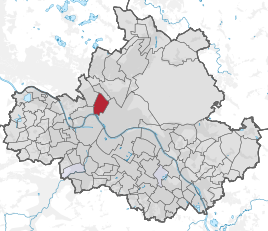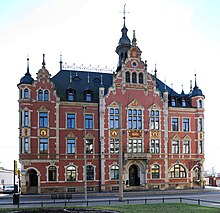Pieschen
|
Pieschen
State capital Dresden
Coordinates: 51 ° 4 ′ 40 ″ N , 13 ° 43 ′ 2 ″ E
|
|
|---|---|
| Height : | 112 m above sea level NN |
| Incorporation : | July 1, 1897 |
| Postal code : | 01129 |
| Area code : | 0351 |
|
Location of the district Pieschen in Dresden
|
|



The Dresden district of Pieschen [ ˈpiːʃən ] is located on the right Elbe in the northwest of the city, in the district of the same name Pieschen . The district Pieschen was divided into the statistical districts of Pieschen-Süd and Pieschen-Nord / Trachenberge .
The first written mention of the Sorbian village Pesczen (= sandy area) goes back to the year 1292. Remains of the village, which was laid out as a lane village, can only be seen today on Robert-Matzke-Strasse and in Altpieschen .
The original fishing village experienced an economic boom with the first German long-distance railway line (1839) and the port completed in 1859 . From 1860 Pieschen developed into a workers' residential area. There were streets in closed construction with three-story houses and backyards.
Since 1890, Altpieschen has not been the center of the district, but Bürgerstrasse and its side streets. A few shops for daily needs can be found along Bürgerstrasse and Oschatzer Strasse. In 1897 Pieschen was one of the first to be incorporated into Dresden.
After the renovation of many buildings, Pieschen has developed into a residential area that is particularly popular with young people in recent years. There were also new shopping opportunities such as the Elbcenter and the malt house.
history
The fruit growing and fishing village of Pieschen was indirectly mentioned for the first time on October 1, 1292 in a certificate of confirmation from Friedrich , Lord of Dresden and the youngest son of the late Margrave Heinrich III. In the Latin document, which is only preserved in copies, Knight Johanne [s] de Pesczen is listed among the witnesses. Another documentary mention was made as Peschen in 1350. The residents of Pieschen lived at this time until the 19th century mainly from fishing, agriculture, fruit and viticulture and beekeeping. Due to poor soil conditions, however, the harvests were only moderate, which meant that the residents were not exactly blessed with wealth. The tranquil rural location on the Elbe made the village a popular excursion destination for the Dresden population in the 19th century.
With the first German long-distance railway line and the construction of the Leipzig train station , industrial areas emerged in the second half of the 19th century. Along the railway line as well as on the Elbe - from Neudorf , not from the old fishing village of Pieschen - commercial enterprises settled in Pieschner Flur, including the sewing machine parts AG and the Eschebach works .
Because of the employees and workers who came with them, the district developed into a workers' residential area. Pieschen became a center of the labor movement . In 1882 the first Saxon consumer association was founded on Konkordienstraße . In 1889 Max Radestock became the managing director here, who in 1903 became the first chairman of the board of the newly founded Central Association of German Consumers and thus headed the German socialist consumer cooperative movement for ten years.
The huge increase in the number of inhabitants - 12,400 in 1890 compared to 347 in 1834 - also created a great housing shortage. After a development plan had been decided, numerous multi-storey apartment buildings were built, some of which were now inhabited by socially disadvantaged citizens. The community had a representative town hall built in 1890/91 . After the incorporation into Dresden in 1897, further residential areas were built. The construction of restaurants, social and cultural facilities for the workers was also promoted. After Pieschen was cleared out of the Parish of Kaditz and became independent in 1884 due to the increase in population , the Markusfriedhof was laid out in 1884 and the Evangelical St. Mark's Church was built in 1886–1888 .
In 1912, city planning officer Hans Erlwein established a modern asylum for homeless men in Altpieschen , which was later converted into a family asylum. Around 90 years after its construction, the residential complex, which is now under monument protection, was in a desolate condition, the renovation of what is now the “ Erlweinhof ” took place from 2004 to 2005.
The Sachsenbad , designed by city planning officer Paul Wolf and built in 1927/28 as a cultural and social facility, was a modern indoor swimming pool with underfloor heated rooms, restaurants and a 25-meter swimming pool. It is an important example of functionalism and the New Objectivity . In addition to fitness, weight training, gymnastics and ball sports, cultural events such as various courses, readings and exhibitions were also offered. It was in operation until the 1990s, but has been vacant for years. The future of the former bathroom is uncertain.
On September 1, 1930, the Northwest Library (today Pieschen) was opened as the fifth full-time branch of the Dresden City Library.
The Pieschener Hafen was laid out in the middle of the 19th century, but it gradually lost its importance with the establishment of the Alberthafen . There was also a dock for steamers and an Elbe swimming pool nearby.
The horse-drawn tram line to Dresden that had existed since 1882 was replaced by the electric tram in 1899 . Today mainly the line 4 (Laubegast – Weinböhla), line 9 (Kaditz – Prohlis) and line 13 (Kaditz / Mickten – Prohlis) of the Dresden public transport company Pieschen with the Dresden city center.
50 victims of the air raids on Dresden in 1945 were buried in the Markusfriedhof
After the political change , Pieschen became the city's second largest redevelopment area in 1991 . Many tenement houses could be saved from decay and give the district its own charm today. Former industrial areas were functionally redesigned ( urban redevelopment ). One example is the former Eschebach works in Riesaer Strasse, which housed the social council house until October 2007.
In addition to the Elbhangfest and the district festival Bunte Republik Neustadt , the “Pieschner Hafenfest” and “St. Pieschen ”to the larger district festivals in Dresden. The harbor festival was celebrated for the first time in 1923. Since the festival was organized by the socialist workers' associations, it was no longer allowed to take place after 1933 for political reasons. In the 1950s, it was revived according to the old tradition, with the Vier Brummers doing great services to Wolfgang Roeder . Since 1997 it has taken place every year in early June.
traffic
Pieschen can be reached with the tram lines 4, 9 and 13 of the Dresdner Verkehrsbetriebe . Several bus routes also run through the district. There is also a connection to the S-Bahn line 1 in the direction of Schöna and Meißen from the Pieschen stop .
The Leipziger Straße arterial road runs through Pieschen towards Radebeul . The Dresden-Neustadt motorway exit of federal motorway 4 is located within the Pieschen district.
Attractions
On the grounds of the depot Trachenberge is the in Pieschen tram museum in Dresden , will be exhibited in the more than 30 cars and other witnesses Dresden tram history.
The Catholic Josefskirche , built in neo-Romanesque style, stands on Rehefelder Strasse , and the Evangelical St. Mark's Church on Bürgerstrasse .
The cultural monuments are listed in the two lists of cultural monuments in Pieschen (A – K) and (L – Z) .
Personalities
- Robert Grießbach (April 3, 1886 - December 25, 1970), chemist
- Alfred Althus (born August 29, 1888; † September 7/8, 1943 in Berlin-Plötzensee), anti-fascist and media politician
- Walter Grellmann (born October 16, 1888; † after 1933), teacher and politician, member of the Saxon state parliament
gallery
Medical center on Wurzener Strasse, built as a community school, later a military hospital, used as a polyclinic in the GDR
The pier bridge at Pieschener Hafen the day after its opening in 2010
literature
- Dresdner Geschichtsverein eV (ed.): In search of the future - The example of Pieschen . Dresdner Hefte , No. 23. Dresden 1990.
- Annette Dubbers-Mittag: Pieschen. From the history of a Dresden district . Sandstone, Dresden 2001.
- Heidemarie and Heinz Glodschei: The history of the Dresden suburb of Pieschen . 2 volumes. Hille, Dresden 2008.
- Cornelius Gurlitt : Pieschen. In: Descriptive representation of the older architectural and art monuments of the Kingdom of Saxony. 24. Issue: Amtshauptmannschaft Dresden-Altstadt (Land) . CC Meinhold, Dresden 1904, p. 99.
Web links
supporting documents
- ^ Karl Friedrich von Posern-Klett (ed.): Document book of the cities of Dresden and Pirna (= Codex diplomaticus Saxoniae regiae . Second main part, 5th volume). Giesecke & Devrient, Leipzig 1875, p. 6 f . ( Online (certificate no. 9) - mention "Johanne de Pesczen" on p. 7, line 31 ).
- ↑ a b Pieschen in the Digital Historical Directory of Saxony
- ↑ Pieschen. In: Dresdner-Stadtteile.de. Retrieved May 17, 2013 .
- ↑ Erlweinhof residential complex Altpieschen. (No longer available online.) In: Bauten.de. Archived from the original on September 23, 2015 ; Retrieved June 9, 2015 . Info: The archive link was inserted automatically and has not yet been checked. Please check the original and archive link according to the instructions and then remove this notice.
- ^ Official website of the Pieschen library
- ^ Holger Hase and Wolfgang Scheder: Dresden war graves . Edited by Volksbund Deutsche Kriegsgräberfürsorge. Dresden 2010. p. 40











